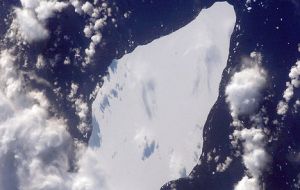MercoPress. South Atlantic News Agency
Iceberg size of Luxembourg knocks loose and could disrupt weather patterns
 The Metz Glacier tongue from where the huge mass of ice broke loose
The Metz Glacier tongue from where the huge mass of ice broke loose An iceberg the size of Luxembourg knocked loose from the Antarctic continent earlier this month could disrupt the ocean currents driving weather patterns around the globe, researchers said on Friday.
While the impact would not be felt for decades or longer, a slowdown in the production of colder, dense water could result in less temperate winters in the north Atlantic, they said.
The 2550 square-kilometre 400 metres thick block broke off on February 12 or 13 from the Mertz Glacier Tongue, a 160-kilometre spit of floating ice protruding into the Southern Ocean from East Antarctica, south of Melbourne, Australia, researchers said.
According to scientists the iceberg could disturb the area's exceptionally rich biodiversity, including a major colony of emperor penguins near Dumont d'Urville, site of a French scientific station, according to the scientists.
“The ice tongue was almost broken already. It was hanging like a loose tooth,” said Benoit Legresy, a French glaciologist who has been monitoring the Metz Glacier via satellite images and on the ground for a decade in co-operation with Australian scientists.
The huge mass was dislodged by another, older iceberg, known as B9B, which split off in 1987.Jammed against the Antarctic continent for more than 20 years, B9B smashed into the Metz tongue like a slow-motion battering ram after it began to drift.
Both natural cycles and manmade climate change contribute to the collapse ice shelves and glaciers. Tide and ocean currents constantly beat against exposed areas, while longer summers and rising temperatures also take a toll.
“Obviously when there is warmer water, these ice tongues will become more fragile,” said Legresy, who works at the Laboratory for Geophysics and Oceanographic Space Research in Toulouse, southern France.
The Metz Glacier Tongue, fitted with GPS beacons and other measurement instruments, could provide crucial insights into how these influences should be apportioned.
“For the first time, we will have a detailed record of the full cycle of a major calving event — before, during and after,” he said.
Since breaking off, the iceberg — along with the newly mobile B9B, which is about the same size — have moved into an adjoining area called a ploynya.
Distributed across the Southern Ocean, ploynyas are zones that produce dense water, super cold and rich in salt that sinks to the bottom of the sea and drives the conveyor-belt like circulation around the globe.
If these icebergs move east and run aground, or drift north into warmer climes, they will have no impact on these currents.
“But if they stay in this area — which is likely — they could block the production of this dense water, essentially putting a lid on the polynya,” Legresy explained.
The Metz Glacier Polynya is particularly strong, and accounts for 20% of the “bottom water” in the world, he added. Eventually, the icebergs will die a natural death, but their lifespan depends on where they go.




Top Comments
Disclaimer & comment rulesCommenting for this story is now closed.
If you have a Facebook account, become a fan and comment on our Facebook Page!